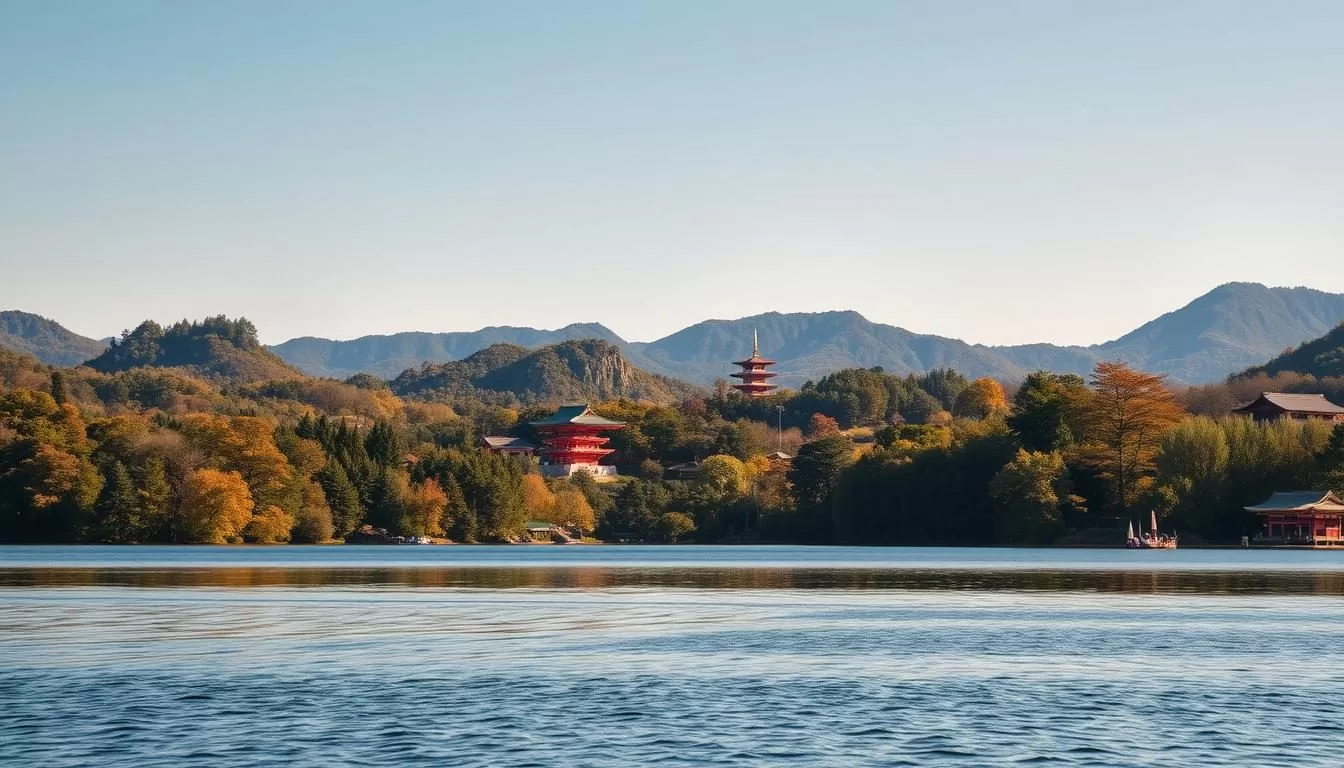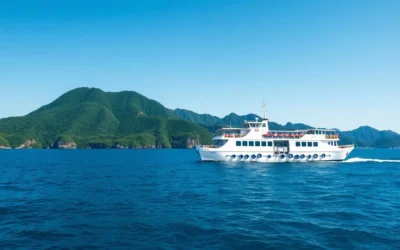✓ Accommodations✓ Flights✓ Rental Cars✓ Tours & Activities
Planning a trip to the Kansai region can be a thrilling experience, especially with its iconic landmarks, beautiful parks, and culturally rich cities like Osaka, Kyoto, Kobe, and Nara.
Understanding the weather patterns and seasonal attractions is crucial for a memorable journey. The region’s distinct four seasons offer unique travel experiences throughout the year.
You’ll want to know the optimal time to visit based on your preferences, whether it’s cherry blossoms, autumn foliage, winter illuminations, or summer festivals. This guide will help you navigate the region’s climate variations and plan your trip around peak tourist seasons and national holidays.
By being weather-savvy, you can maximize your time in this historically significant region and enjoy a more relaxed, crowd-free experience.
Understanding Kansai’s Climate and Seasons
The Kansai region’s unique geography plays a significant role in shaping its climate. Located in southern Japan, Osaka, a major city in the Kansai region, experiences a mild climate compared to other areas.
Geographic Influence on Weather Patterns
The region’s position between mountains and the sea creates its distinctive weather patterns throughout the year. This unique geography contributes to the varying temperatures and precipitation levels across different areas of Kansai.
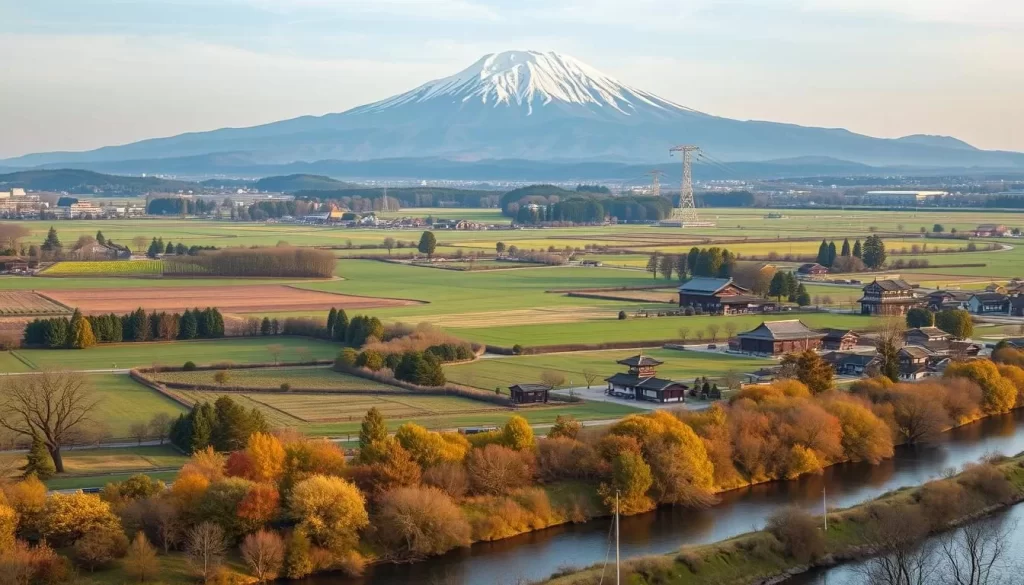
Four Distinct Seasons Overview
Kansai experiences four clearly defined seasons, each offering different weather conditions and travel experiences. From the hot summers to the mild springs and autumns, and cool winters, the region’s seasonal variations are pronounced.
Temperature and Precipitation Averages
The average highs in Kansai range from 48°F (9°C) in winter to 90°F (32°C) in summer. August is typically the hottest month, with temperatures often reaching 91°F (32°C), while January is the coldest. Summer brings significant rainfall, with June being the wettest month, receiving about 9 inches of rain due to the summer monsoon season.
Spring in Kansai: Cherry Blossoms and Mild Weather
Spring in Kansai is a magical time, with mild weather and stunning cherry blossoms. As winter’s chill dissipates, the region transforms into a vibrant landscape, perfect for travelers.
March to May Weather Conditions
During spring, Kansai experiences a gradual warming trend. In March, temperatures range around 56°F (13°C) during the day and 41°F (5°C) at night. By April, the average highs reach 66°F (19°C), with lows of 50°F (10°C). May brings pleasant temperatures, with highs of 75°F (24°C) and lows of 59°F (15°C).
| Month | Average High | Average Low |
|---|---|---|
| March | 56°F (13°C) | 41°F (5°C) |
| April | 66°F (19°C) | 50°F (10°C) |
| May | 75°F (24°C) | 59°F (15°C) |
Cherry Blossom Season Timing
The cherry blossom season typically occurs from late March to early April in Kansai, blooming earlier than in Tokyo. This period, known as hanami, is a peak tourist season.
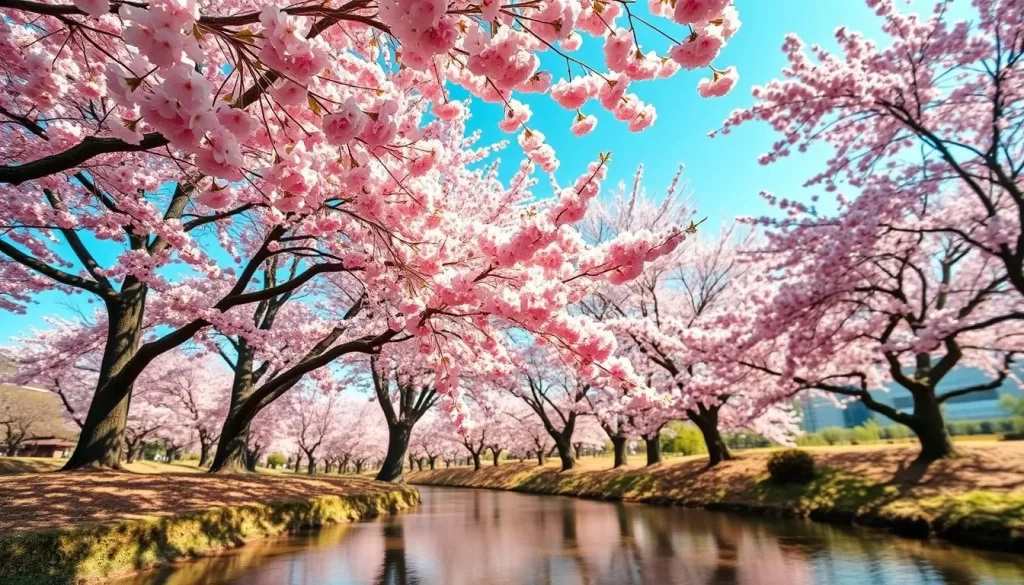
Spring Festivals and Cultural Events
Spring in Kansai is not just about the cherry blossoms; it’s also a time for various festivals and cultural events. The Miyako Odori (Cherry Blossom Dance) in Kyoto and the Inari Festival at Fushimi Inari Shrine are highlights, showcasing the region’s rich cultural heritage.
What to Pack for Spring Travel
For a comfortable trip, pack light layers for fluctuating temperatures and comfortable walking shoes for exploring outdoor attractions.
Spring is considered by many to be the best time to visit Kansai, despite the crowds during peak cherry blossom season. With some planning, you can enjoy the hanami without the chaos.
Summer in the Kansai Region: Heat, Humidity, and Festivities
Summer in Kansai is a season of sweltering heat and vibrant festivities that showcase the region’s rich cultural heritage. The period from June to August is characterized by high temperatures often exceeding 90°F (32°C), accompanied by high humidity levels.
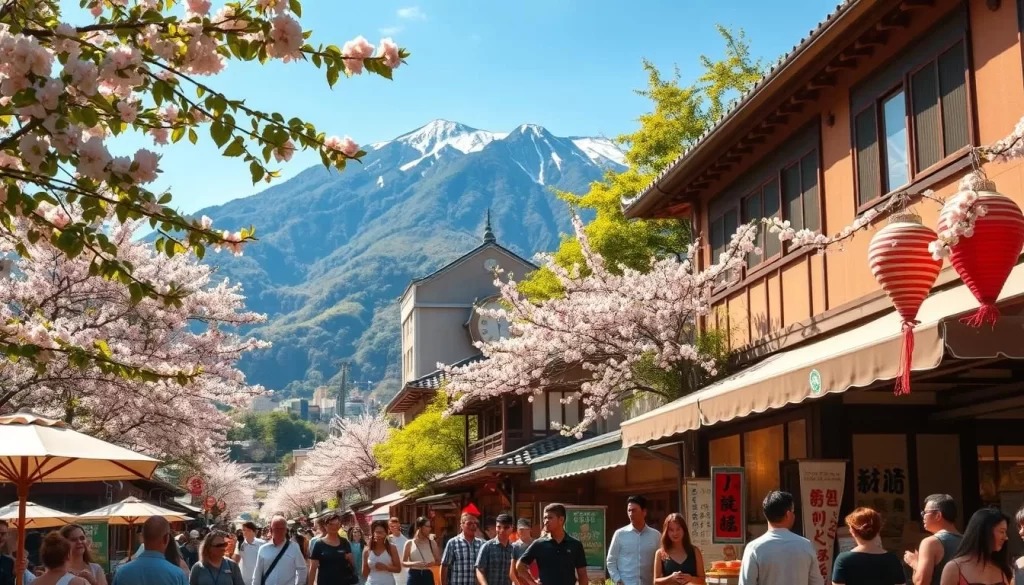
June to August Temperature and Rainfall
During the summer months, Kansai experiences its hottest time of the year. June marks the beginning of the rainy season, known as “tsuyu,” which lasts until late July. This period is characterized by frequent rain showers, with June being Osaka’s wettest month with about 9.0 inches (229 mm) of rain.
Navigating the Rainy Season
Visitors should be prepared for the rain by bringing appropriate gear such as umbrellas and raincoats. Clothing that dries quickly is also recommended. Despite the rain, the weather is not typically all-day rain, allowing for some outdoor activities.
Summer Festivals and Fireworks
Summer in Kansai is not just about the heat; it’s also a time for numerous festivals and fireworks displays. Events like Kyoto’s Gion Matsuri and Osaka’s Tenjin Matsuri are highlights, offering a glimpse into the region’s cultural traditions.
Tips for Staying Comfortable in Summer Heat
To stay comfortable, it’s essential to stay hydrated, wear light, moisture-wicking clothing, and plan indoor activities during the hottest part of the day. Enjoying local cooling treats like kakigori (shaved ice) and cold somen noodles can also help beat the heat.
Despite the challenging weather, summer can be a budget-friendly time to visit Kansai, with lower hotel prices and fewer international people. With plenty of things to see and do, you’re sure to have a memorable trip.
Fall in Kansai: Autumn Colors and Pleasant Days
As the summer heat dissipates, the Kansai region transforms into a vibrant autumn paradise, making fall an ideal time to visit. You’ll experience some of Kansai’s most pleasant weather during fall, with temperatures gradually cooling from September’s warm 84°F (29°C) to November’s mild 63°F (17°C).
September to November Weather Patterns
The autumn weather in Kansai is generally pleasant, with clear skies and long days. However, September can see significant rainfall due to typhoons, so it’s essential to be prepared. By November, the temperatures drop, making it cooler and more comfortable for outdoor activities.
Best Spots for Autumn Foliage
Kansai is home to numerous breathtaking autumn foliage spots. Some of the top destinations include Kyoto’s Tofukuji Temple and Arashiyama district, Osaka’s Minoh Park, and Nara Park, where the fall colors provide a stunning backdrop for the famous free-roaming deer. 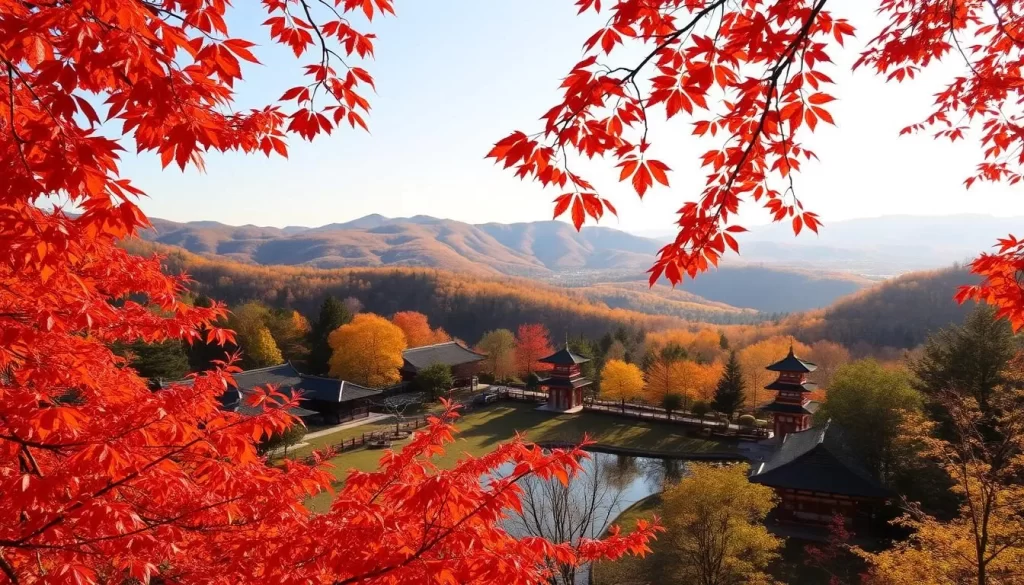
Fall Festivals and Events
Fall is also a time for vibrant festivals and events in Kansai. You can experience the Jidai Matsuri (Festival of Ages) in Kyoto and the Danjiri Matsuri in southern Osaka, featuring traditional performances and cultural displays. These events add to the region’s autumn charm, making it a great time to visit.
Packing Essentials for Autumn Travel
When traveling to Kansai in the fall, it’s recommended to pack light layers for fluctuating temperatures and comfortable walking shoes for exploring the region’s many outdoor attractions. This will ensure you’re well-prepared to enjoy the best of what Kansai has to offer during the autumn season.
- Enjoy the gradual cooling of temperatures from September to November.
- Explore the region’s most spectacular autumn viewing spots.
- Experience the vibrant fall festivals and events.
- Pack accordingly for the fluctuating autumn temperatures.
Winter Experiences: Mild Temperatures and Fewer Crowds
Kansai’s winter season is a hidden gem, providing a serene and less crowded travel experience. Unlike other parts of Japan, the Kansai region enjoys a relatively mild climate during the winter months.
December to February Weather Overview
During December, January, and February, Kansai experiences cool to mild temperatures, ranging from 35°F (2°C) to 53°F (12°C). Temperatures rarely drop below freezing, making it an ideal time for those who prefer milder weather. You can expect mostly dry and calm conditions, perfect for outdoor activities and sightseeing.
Winter Illuminations and Seasonal Events
Winter in Kansai is illuminated with spectacular light displays and festive events. Enjoy Kyoto’s Arashiyama Hanatouro, Kobe’s Luminarie, and Osaka’s Festival of the Lights, which transform the cities into magical winter wonderlands. These events are a great way to experience the local culture and festive atmosphere.
Winter Food Specialties
Warm up with Kansai’s winter food specialties, including hot pot dishes like oden and nabe, as well as seasonal street foods such as roasted sweet potatoes from yaki-imo trucks. These delicious treats are perfect for enjoying during the cooler months.
What to Wear During Kansai Winters
To stay comfortable during your winter visit, pack warm clothing, including a thick jacket, scarf, gloves, and hat. Layering is key to adjusting to temperature variations between outdoor exploration and heated indoor spaces. This will ensure you’re prepared for a comfortable trip.
Kansai Region, Japan: Best Months for a Weather-Savvy Trip
If you’re considering a trip to Japan’s Kansai region, knowing the best months to visit can make all the difference in your travel experience. The Kansai region, encompassing cities like Osaka, Kyoto, and Kobe, offers a rich tapestry of cultural, historical, and natural attractions that are best enjoyed during certain times of the year.
Optimal Months for First-Time Visitors
For those visiting the Kansai region for the first time, late April to early May and October to November are generally considered the best times. These periods offer mild weather and spectacular seasonal beauty, making them ideal for exploring the region’s many attractions.
Best Times for Budget Travelers
Budget-conscious travelers should consider visiting during January-February or June-July. During these periods, hotel rates tend to be lower, and popular tourist attractions are less crowded, making for a more economical and relaxed travel experience.
| Month | Weather | Attractions |
|---|---|---|
| April | Mild | Cherry Blossoms |
| October | Comfortable | Autumn Foliage |
| January | Cold | Winter Illuminations |
Ideal Periods for Outdoor Activities
For outdoor enthusiasts, spring and fall are the best seasons to visit the Kansai region. These periods offer the perfect conditions for hiking in places like Mount Hiei and along the Kumano Kodo pilgrimage routes.
When to Visit Specific Kansai Attractions
Certain attractions in the Kansai region are best visited during specific times. For example, Fushimi Inari Shrine is particularly beautiful during cherry blossom season, while Himeji Castle is stunning during autumn foliage.
By understanding the best times to visit the Kansai region, you can plan a trip that balances good weather, manageable crowds, and reasonable prices, ensuring a memorable and enjoyable travel experience.
Times to Avoid: Peak Tourist Seasons and National Holidays
When planning your trip to the Kansai region, it’s crucial to be aware of the peak tourist seasons and national holidays that can significantly impact your travel experience. While these periods can be exciting for some, they often result in crowded attractions, higher prices, and a generally more hectic travel environment.
Golden Week: A Peak Travel Period
Golden Week, which typically falls in late April to early May, is one of the most challenging times to visit Kansai. During this week-long holiday, domestic tourism reaches its peak, causing transportation systems to become overwhelmed and accommodation prices to skyrocket. If you’re planning to travel during this time, make sure to book your accommodations and travel arrangements well in advance.
Obon Festival and Summer Vacation
The Obon Festival in mid-August, combined with summer vacation, creates another significant travel surge. Popular destinations like Kyoto and Nara become particularly crowded during this period. If you’re visiting during this time, be prepared for larger crowds and potentially higher prices for accommodations and tourist services.
New Year Holiday Period
The New Year holiday period, from December 29 to January 3, can also be problematic for travelers. Many businesses are closed during this time, and transportation services operate on limited schedules. While it can be a unique time to experience local culture, it’s essential to plan ahead for the closures and limited services.
Cherry Blossom Peak Season Crowds
The peak cherry blossom season, usually occurring in late March to early April, attracts massive crowds. While it’s a beautiful time to visit, the popularity of this season means that popular spots can be extremely crowded. To enjoy the blossoms without getting caught in the worst congestion, consider visiting popular spots early in the morning or later in the evening.
- Plan ahead and book your accommodations and travel arrangements early to avoid higher prices and availability issues.
- Consider alternative destinations within the Kansai region that may be less crowded during peak seasons.
- Adjust your daily schedule to avoid the peak tourist hours, usually around mid-day.
Weather-Based Itinerary Planning for Kansai

The key to a successful Kansai trip lies in understanding and adapting to the local weather patterns. With its diverse climate, Kansai offers a unique experience in every season. Whether you’re looking to enjoy the cherry blossoms in spring or the autumn foliage, planning your trip around the weather ensures a memorable experience.
Rainy Day Alternatives in Major Cities
On rainy days, visit world-class museums like the National Museum of Art in Osaka or enjoy thrilling rides at Universal Studios Japan. These indoor attractions provide a perfect escape from the rain, making your trip enjoyable regardless of the weather.
Seasonal Day Trips from Osaka and Kyoto
Each season offers unique opportunities for day trips. In spring, visit Yoshino for breathtaking cherry blossoms, while autumn is ideal for exploring Arashiyama. Summer is perfect for a cool retreat to Mount Koya, and winter offers serene landscapes in the Japanese Alps.
Transportation Considerations by Season
The choice of transportation can significantly impact your trip. Consider purchasing a JR Pass or Kansai Thru Pass, especially during peak travel seasons, to maximize your travel convenience and value.
Accommodation Recommendations Based on Weather
Choose accommodations that suit the weather. Hotels with onsen (hot springs) are ideal during winter, while properties with air conditioning are a must for the hot summer months. This ensures a comfortable stay throughout your trip.
Conclusion
The Kansai region is a year-round destination, but timing your visit right can enhance your experience. You’ve learned how weather patterns affect travel throughout the year. From cherry blossoms in spring to autumn’s foliage and winter’s illuminations, each season offers unique attractions. To make sure you have the best time to visit, consider your priorities: ideal weather, budget, or avoiding crowds. By doing so, you’ll be able to plan a trip that suits your preferences during the best months to visit the Kansai region.
The above is subject to change.
Check back often to TRAVEL.COM for the latest travel tips and deals.
